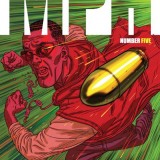
COMIC BOOK REVIEW: MPH #5 = Millar’s Procastinated Hype
I have some issues with Mark Millar’s way of ending his titles. First, they are delayed; way so long that I almost forgot they existed until I check my lists in the comic internet sites. Second are the forces behind the delays. I know Millar is no sloth in crafting stories he specializes so well. […]
I have some issues with Mark Millar’s way of ending his titles. First, they are delayed; way so long that I almost forgot they existed until I check my lists in the comic internet sites. Second are the forces behind the delays. I know Millar is no sloth in crafting stories he specializes so well. The only things I can think of are the artists’ respective style of illustration (read: Frank Quitely, Bryan Hitch and Steve McNiven), and his ever increasing opportunities he has right now beyond comic writing (read: movie consultations, political advisor, pitching his indie-owned creations to Hollywood, among others).
If there are other motives than what I suspect, its Millar’s alone. But that’s equally frustrating for those who invested in his works, particularly titles that are an issue away to the finale. From what I see this pattern, his final chapter are often thicker, more expensive, more action-packed, tying all-loosed ends altogether (unless he wants a sequel similar to Kick-Ass, Nemesis, Jupiter’s Legacy, and still, American Jesus). This year alone, titles like Jupiter’s Legacy and MPH just concluded which should have been done last year. His Starlight was the fastest yet in recent memory (a bit delayed a month, but yet finished not for the sake of being dragged on). Speaking on the latter, MPH #5 is just released. Is it worth the wait? Is it worth our hard-earned savings? Is it worth reading at all? In true Millar fashion (and so hard to admit), the answer is YES.
When the trio of urban drug-powered reformists tries to confront the ultimate foe, things go so UNEXPECTEDLY. Most of Millar’s finales are so predictable, though engagingly entertaining. But this time around, so uncanny he pulled off that I really had to reread the material a couple of times. So unpredictable, I once suspected that Millar was the actual plot master at all. After a couple of readings, I realized how clever this Scottish scribe is. I never ever expected that kind of delivery he showed to the unsuspected readers. Most possibly, he paid homage to the likes of The Flash, the first Superman movie, and classic time-travelling sci-fi genres. You have to watch these types to get my point here. Also, he wrapped up the entire story by surprising us what happened to one of the characters in the cliffhanging moment in issue four. Similar to his brand of optimistic point-of-view, this is indeed a very, very uplifting and positive story. Cliché, of course, but at least we are treated so nicely and more engagingly.
The art is the strongest factor here. Similar to most of Millar’s indie-owned creations, the super-detailed illustrations of co-creator Duncan Fegredo are so stunning and well-crafted that readers can assume that he really meticulously studied his subjects and objects so well that they are virtually so real and at the same time, artistically breathtaking. I am aware of Duncan’s minor inconsistencies here, like the face of Rosa that looks a bit aged even after “three weeks” of the unbelievable twist and the main protagonist whose looks are so similarly striking to a certain Hollywood superstar.
MPH #5 ends well, seriously. Yet the caveat here is the tardiness that truly betrays the name, the plot, and the story themselves. And similar to his most of his creator-owned stuffs, it may satisfy our hunger though it may not be memorable in the long run. Perhaps, a movie adaptation may be in the works to serve the comics’ relevance about the widening wealth gap of two opposing forces in America.



















